3.Request和Respons
Request&Response-授课
1 响应对象
1.1 响应对象概述
1.1.1 关于响应
响应,它表示了服务器端收到请求,同时也已经处理完成,把处理的结果告知用户。简单来说,指的就是服务器把请求的处理结果告知客户端。在B/S架构中,响应就是把结果带回浏览器。
响应对象,顾名思义就是用于在JavaWeb工程中实现上述功能的对象。
1.1.2 常用响应对象
响应对象也是是Servlet规范中定义的,它包括了协议无关的和协议相关的。
协议无关的对象标准是:ServletResponse接口
协议相关的对象标准是:HttpServletResponse接口
类结构图如下:
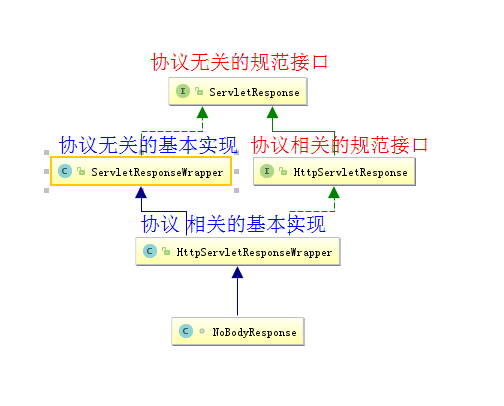
我们课程中涉及的响应对象都是和HTTP协议相关的。即使用的是HttpServletResponse接口的实现类。
这里有些同学可能会产生疑问,我们在使用Servlet时,需要定义一个类,然后实现Servlet接口(或者继承它的实现类)。现在我们想要实现响应功能,要不要定义一个类,然后实现HttpServletResponse接口呢?
此问题的答案是否定的,我们无需这么做。我们只需要在自己写的Servlet中直接使用即可,因为这个对象的实现类是由Tomcat提供的,无须我们自定义。同时它还会帮我们把对象创建出来并传入doGet和doPost方法中。
1.2 常用方法介绍
在HttpServletResponse接口中提供了很多方法,接下来我们通过API文档,来了解一下这些方法。
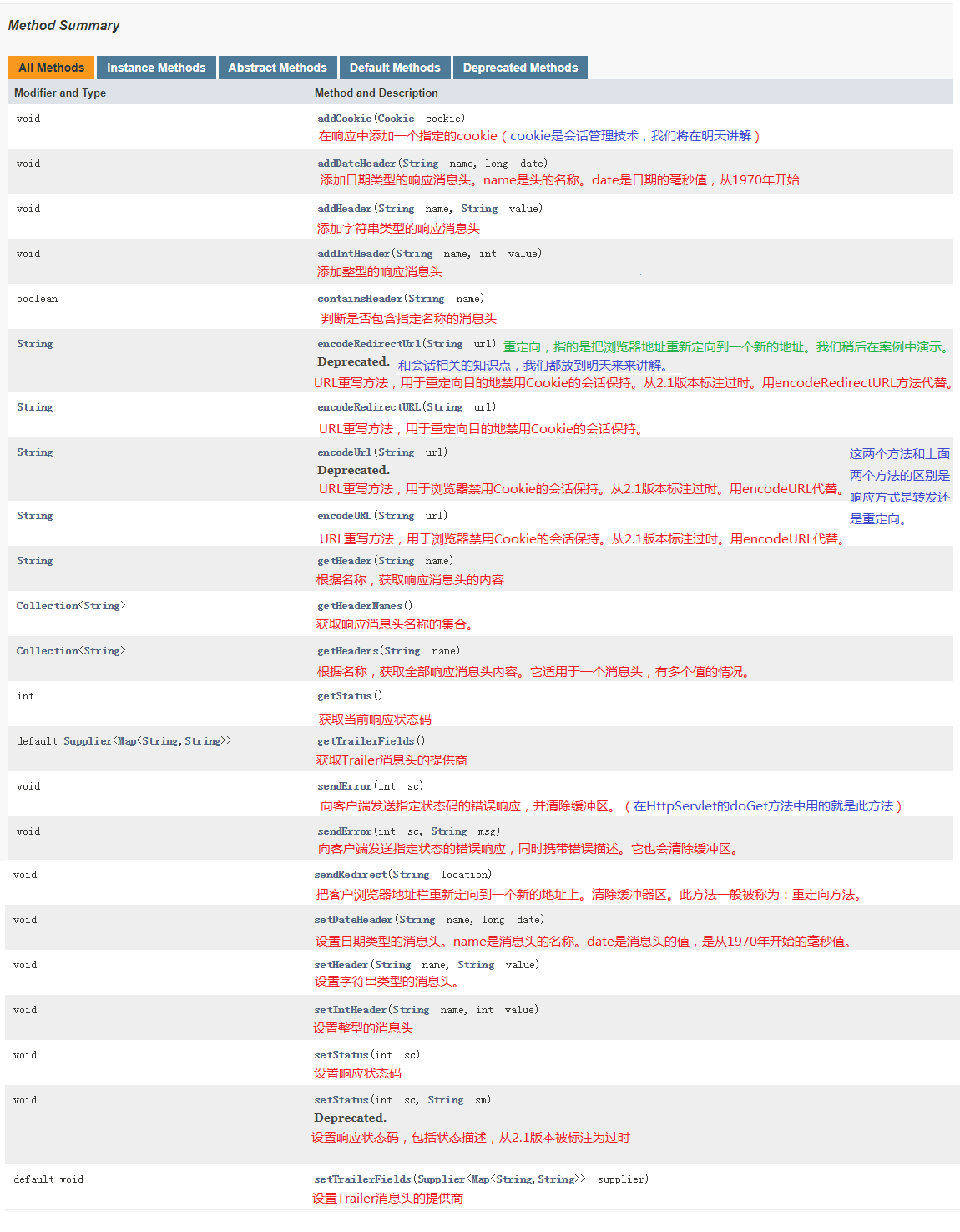
常用状态码:
| 状态码 | 说明 |
|---|---|
| 200 | 执行成功 |
| 302 | 它和307一样,都是用于重定向的状态码。只是307目前已不再使用 |
| 304 | 请求资源未改变,使用缓存。 |
| 400 | 请求错误。最常见的就是请求参数有问题 |
| 404 | 请求资源未找到 |
| 405 | 请求方式不被支持 |
| 500 | 服务器运行内部错误 |
状态码首位含义:
| 状态码 | 说明 |
|---|---|
| 1xx | 消息 |
| 2xx | 成功 |
| 3xx | 重定向 |
| 4xx | 客户端错误 |
| 5xx | 服务器错误 |
1.3 响应对象的使用示例
1.3.1 响应-字节流输出中文问题
/**
* @author 黑马程序员
* @Company http://www.itheima.com
*/
public class ResponseDemo1 extends HttpServlet {
/**
* 演示字节流输出的乱码问题
*/
public void doGet(HttpServletRequest request, HttpServletResponse response)
throws ServletException, IOException {
/**
* 问题:
* String str = "字节流中文乱码问题";
* 使用字节流输出,会不会产生中文乱码?
* 答案:
* 会产生乱码
* 原因:
* String str = "字节流中文乱码问题"; 在保存时用的是IDEA创建文件使用的字符集UTF-8。
* 到浏览器上显示,chrome浏览器和ie浏览器默认的字符集是GB2312(其实就是GBK),存和取用的不是同一个码表,就会产生乱码。
*
* 引申:
* 如果产生了乱码,就是存和取用的不是同一个码表
* 解决办法:
* 把存和取的码表统一。
*/
String str = "字节流输出中文的乱码问题";//UTF-8的字符集,此时浏览器显示也需要使用UTF-8的字符集。
//1.拿到字节流输出对象
ServletOutputStream sos = response.getOutputStream();
/**
* 解决办法:
* 第一种解决办法:
* 修改浏览器的编码,使用右键——编码——改成UTF-8。(不推荐使用,我们的应用尽量不要求用户取做什么事情)
* ie和火狐浏览器可以直接右键设置字符集。而chrome需要安装插件,很麻烦。
* 第二种解决办法: (不建议使用,因为不好记)
* 向页面上输出一个meta标签,内容如下: <meta http-equiv="content-type" content="text/html;charset=UTF-8">
* 其实它就是指挥了浏览器,使用哪个编码进行显示。
* 第三种解决办法:
* 设置响应消息头,告知浏览器响应正文的MIME类型和字符集
* response.setHeader("Content-Type","text/html;charset=UTF-8");
* 第四种解决办法:我们推荐使用的办法
* 它的本质就是设置了一个响应消息头
* response.setContentType("text/html;charset=UTF-8");
*/
//第二种解决办法:sos.write("<meta http-equiv='content-type' content='text/html;charset=UTF-8'>".getBytes());
//第三种解决办法:response.setHeader("Content-Type","text/html;charset=UTF-8");
//第四种解决办法:
response.setContentType("text/html;charset=UTF-8");
//2.把str转换成字节数组之后输出到浏览器
sos.write(str.getBytes("UTF-8"));
}
public void doPost(HttpServletRequest request, HttpServletResponse response)
throws ServletException, IOException {
doGet(request, response);
}
}
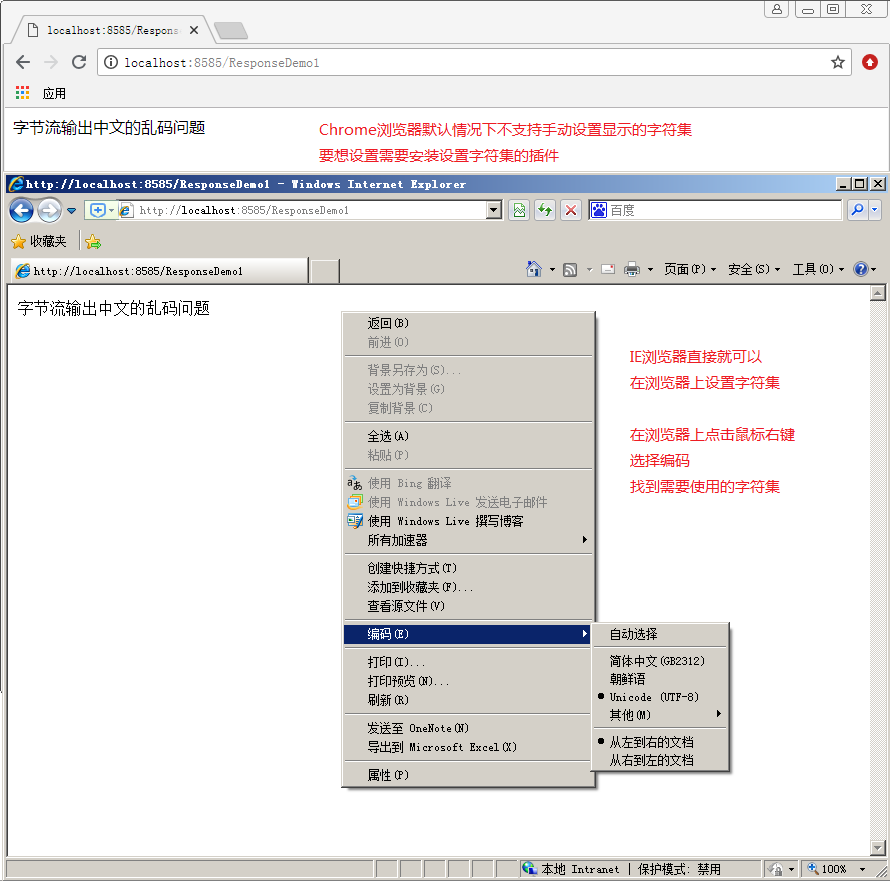
1.3.2 响应-字符流输出中文问题
/**
* @author 黑马程序员
* @Company http://www.itheima.com
*/
public class ResponseDemo2 extends HttpServlet {
/**
* 字符流输出中文乱码
* @param request
* @param response
* @throws ServletException
* @throws IOException
*/
public void doGet(HttpServletRequest request, HttpServletResponse response)
throws ServletException, IOException {
String str = "字符流输出中文乱码";
//response.setCharacterEncoding("UTF-8");
//设置响应正文的MIME类型和字符集
response.setContentType("text/html;charset=UTF-8");/
//1.获取字符输出流
PrintWriter out = response.getWriter();
//2.使用字符流输出中文
/**
* 问题:
* out.write(str); 直接输出,会不会产生乱码
* 答案:
* 会产生乱码
* 原因:
* 存用的什么码表:UTF-8
* 在浏览器取之前,字符流PrintWriter已经获取过一次了,PrintWriter它在取的时候出现了乱码。
* 浏览器取默认用的是GBK。(本地系统字符集)
*
* UTF-8(存)————>PrintWriter ISO-8859-1(取) 乱
* PrintWirter ISO-8859-1(存)————>浏览器 GBK(取) 乱
*
* 解决办法:
* 改变PrintWriter的字符集,PrintWriter是从response对象中获取的,其实设置response的字符集。
* 注意:设置response的字符集,需要在拿流之前。
* response.setCharacterEncoding("UTF-8");
*
* response.setContentType("text/html;charset=UTF-8");
* 此方法,其实是做了两件事:
* 1.设置响应对象的字符集(包括响应对象取出的字符输出流)
* 2.告知浏览器响应正文的MIME类型和字符集
*/
out.write(str);
}
public void doPost(HttpServletRequest request, HttpServletResponse response)
throws ServletException, IOException {
doGet(request, response);
}
}
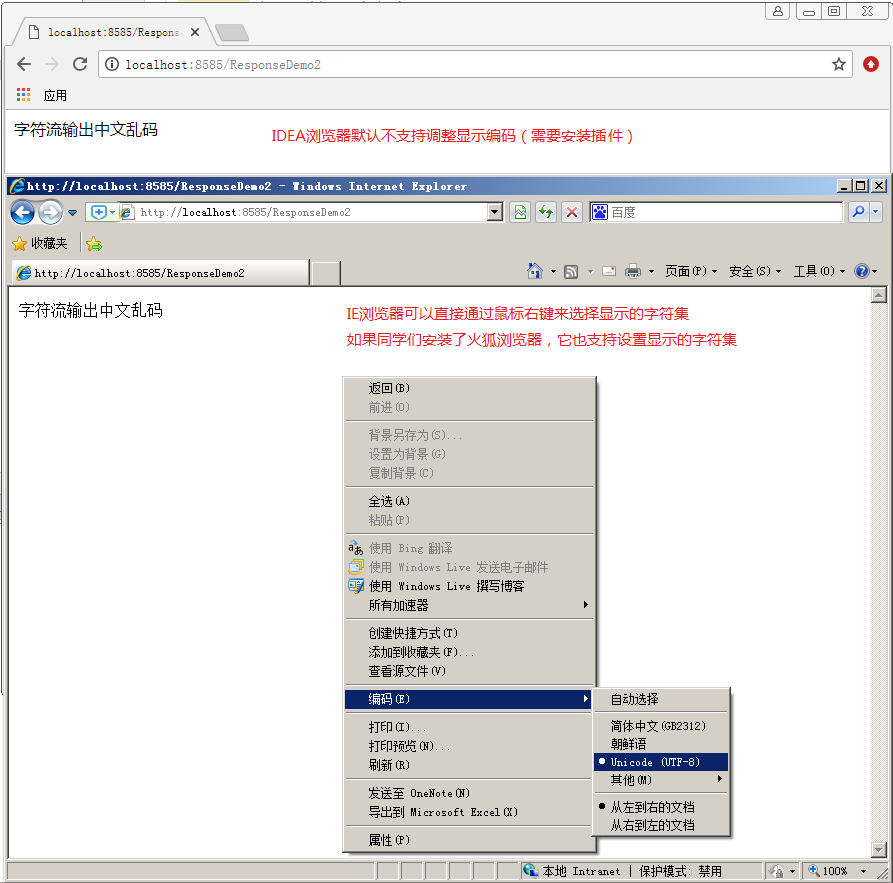
1.3.3 响应-生成验证码
/**
* @author 黑马程序员
* @Company http://www.itheima.com
*
*/
public class ResponseDemo3 extends HttpServlet {
/**
* 输出图片
* @param request
* @param response
* @throws ServletException
* @throws IOException
*/
public void doGet(HttpServletRequest request, HttpServletResponse response)
throws ServletException, IOException {
int width = 200;
int height = 35;
/**
* 实现步骤:
* 1.创建图像内存对象
* 2.拿到画笔
* 3.设置颜色,画矩形边框
* 4.设置颜色,填充矩形
* 5.设置颜色,画干扰线
* 6.设置颜色,画验证码
* 7.把内存图像输出到浏览器上
*/
//创建内存图像
BufferedImage image = new BufferedImage(width,height,BufferedImage.TYPE_INT_RGB);//参数:宽度,高度 (指的都是像素),使用的格式(RGB)
Graphics g = image.getGraphics();//画笔就一根
//设置颜色
g.setColor(Color.BLUE);
//画边框
g.drawRect(0, 0, width, height);
//设置颜色
g.setColor(Color.GRAY);
//填充矩形
g.fillRect(1, 1, width-2, height-2);
//设置颜色
g.setColor(Color.WHITE);
//拿随机数对象
Random r = new Random();
//画干扰线 10条
for(int i=0;i<10;i++){
g.drawLine(r.nextInt(width), r.nextInt(height),r.nextInt(width), r.nextInt(height));
}
//设置颜色
g.setColor(Color.RED);
//改变字体大小
Font font = new Font("宋体", Font.BOLD,30);//参数:1字体名称。2.字体样式 3.字体大小
g.setFont(font);//设置字体
//画验证码 4个
int x = 35;//第一个数的横坐标是35像素
for(int i=0;i<4;i++){
//r.nextInt(10)+""这种写法效率是十分低的
g.drawString(String.valueOf(r.nextInt(10)), x, 25);
x+=35;
}
//输出到浏览器上
//参数: 1.内存对象。2.输出的图片格式。3.使用的输出流
ImageIO.write(image, "jpg", response.getOutputStream());
}
public void doPost(HttpServletRequest request, HttpServletResponse response)
throws ServletException, IOException {
doGet(request, response);
}
}
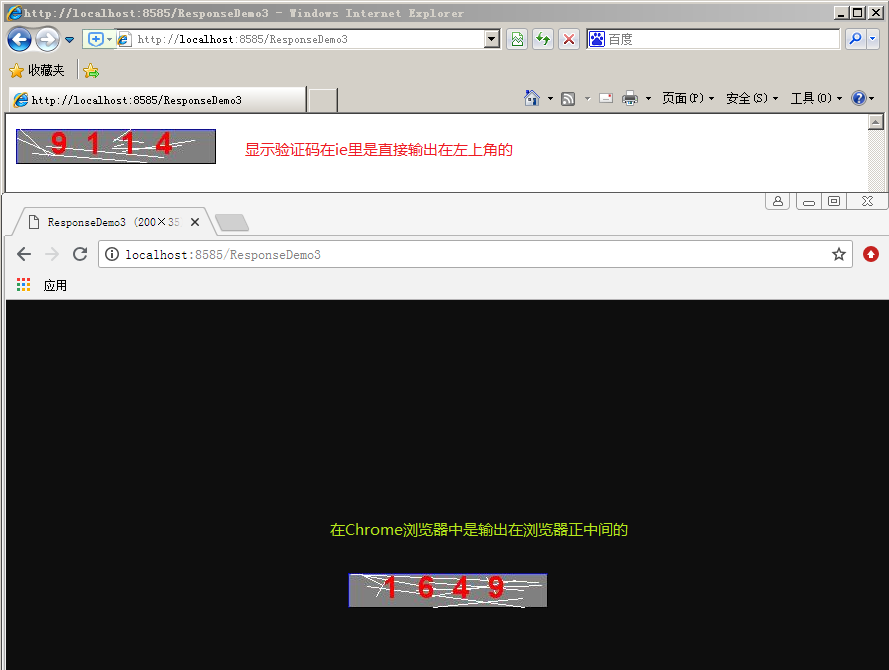
1.3.3 (2)响应-图片到浏览器
/*
响应图片到浏览器
*/
@Override
protected void doGet(HttpServletRequest req, HttpServletResponse resp) throws ServletException, IOException {
//通过文件的相对路径来获取文件的绝对路径
String realPath = getServletContext().getRealPath("/img/hm.png");
System.out.println(realPath);
BufferedInputStream bis = new BufferedInputStream(new FileInputStream(realPath));
//获取字节输出流对象
ServletOutputStream sos = resp.getOutputStream();
//循环读写
byte[] arr = new byte[1024];
int len;
while((len = bis.read(arr)) != -1) {
sos.write(arr,0,len);
}
bis.close();
sos.close();
}
1.3.4 设置响应消息头-控制缓存
/**
* 设置缓存时间
* 使用缓存的一般都是静态资源
* 动态资源一般不能缓存。
* 我们现在目前只掌握了Servlet,所以用Servlet做演示
* @author 黑马程序员
* @Company http://www.itheima.com
*
*/
public class ResponseDemo4 extends HttpServlet {
public void doGet(HttpServletRequest request, HttpServletResponse response)
throws ServletException, IOException {
String str = "设置缓存时间";
/*
* 设置缓存时间,其实就是设置响应消息头:Expires 但是值是一个毫秒数。
* 使用的是
* response.setDateHeader();
*
* 缓存1小时,是在当前时间的毫秒数上加上1小时之后的毫秒值
*/
response.setDateHeader("Expires",System.currentTimeMillis()+1*60*60*1000);
response.setContentType("text/html;charset=UTF-8");
response.getOutputStream().write(str.getBytes());
}
public void doPost(HttpServletRequest request, HttpServletResponse response)
throws ServletException, IOException {
doGet(request, response);
}
}
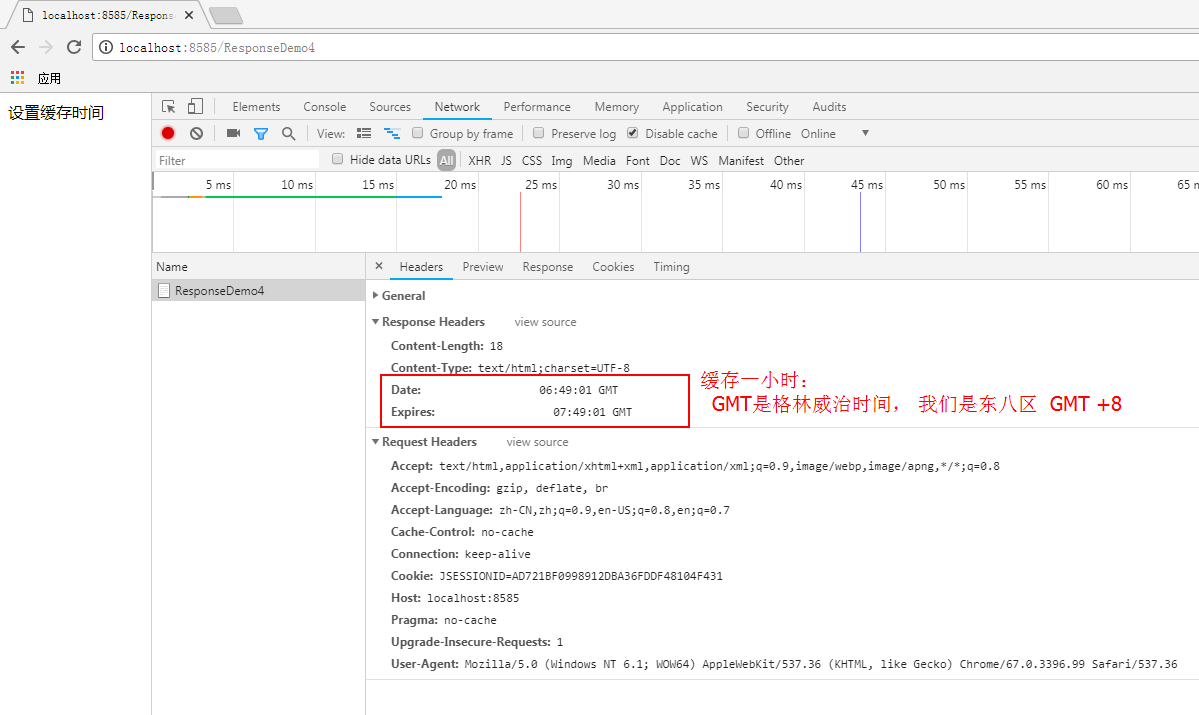
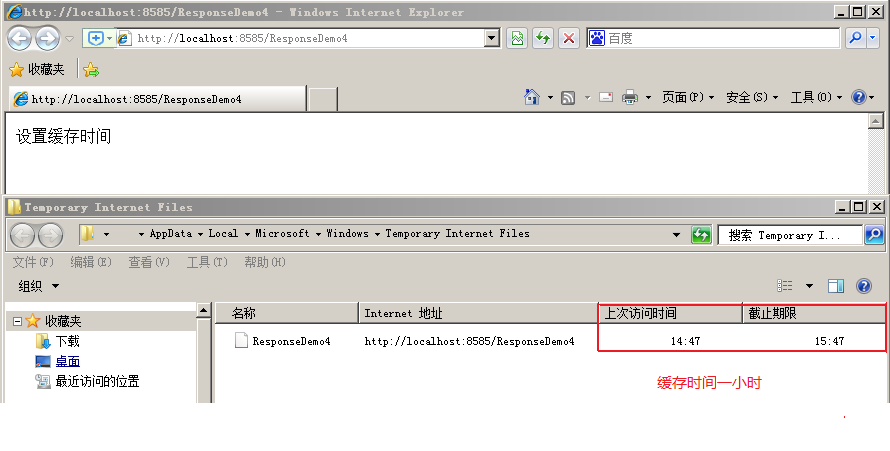
1.3.5 设置响应消息头定时刷新
/**
* 设置响应消息头:
* 通过定时刷新演示添加消息头
* @author 黑马程序员
* @Company http://www.itheima.com
*
*/
public class ResponseDemo5 extends HttpServlet {
public void doGet(HttpServletRequest request, HttpServletResponse response)
throws ServletException, IOException {
String str = "用户名和密码不匹配,2秒后转向登录页面...";
response.setContentType("text/html;charset=UTF-8");
PrintWriter out = response.getWriter();
out.write(str);
//定时刷新,其实就是设置一个响应消息头
response.setHeader("Refresh", "2;URL=/login.html");//Refresh设置的时间单位是秒,如果刷新到其他地址,需要在时间后面拼接上地址
}
public void doPost(HttpServletRequest request, HttpServletResponse response)
throws ServletException, IOException {
doGet(request, response);
}
}
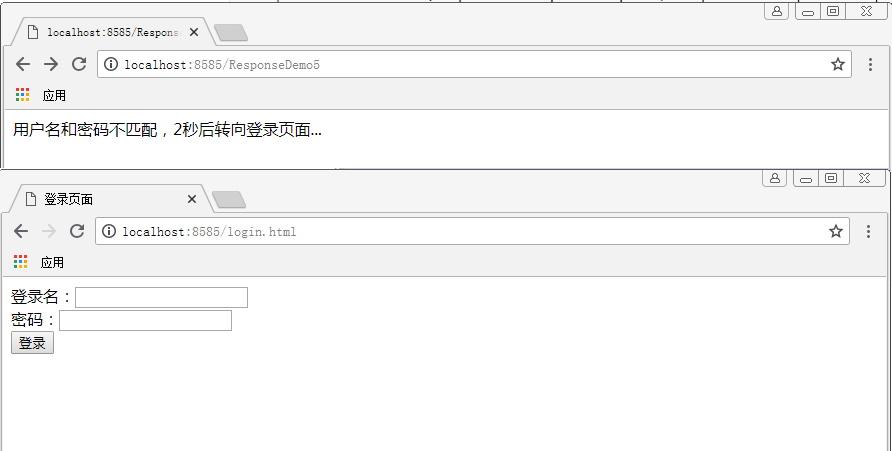
1.3.6 请求重定向:注意地址栏发生改变。
/**
* 设置响应状态码,实现重定向
* 重定向的特点:
* 两次请求,地址栏改变,浏览器行为,xxxx
* @author 黑马程序员
* @Company http://www.itheima.com
*
*/
public class ResponseDemo6 extends HttpServlet {
public void doGet(HttpServletRequest request, HttpServletResponse response)
throws ServletException, IOException {
//1.设置响应状态码
// response.setStatus(302);
//2.定向到哪里去: 其实就是设置响应消息头,Location
// response.setHeader("Location", "ResponseDemo7");
//使用重定向方法
response.sendRedirect("ResponseDemo7");//此行做了什么事,请看上面
}
public void doPost(HttpServletRequest request, HttpServletResponse response)
throws ServletException, IOException {
doGet(request, response);
}
}
/**
* 重定向的目的地
* @author 黑马程序员
* @Company http://www.itheima.com
*/
public class ResponseDemo7 extends HttpServlet {
public void doGet(HttpServletRequest request, HttpServletResponse response)
throws ServletException, IOException {
response.getWriter().write("welcome to ResponseDemo7");
}
public void doPost(HttpServletRequest request, HttpServletResponse response)
throws ServletException, IOException {
doGet(request, response);
}
}
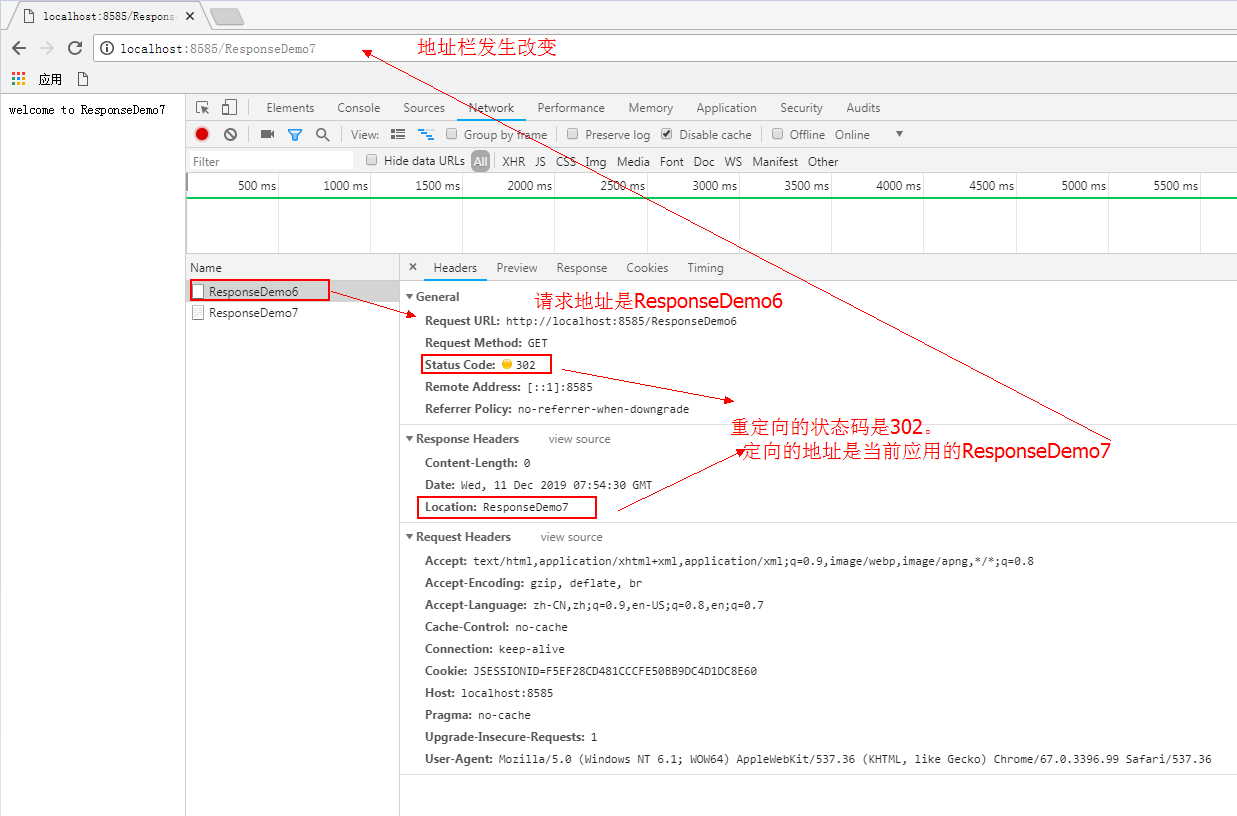
1.3.7 响应和消息头组合应用-文件下载
首先,在工程的web目录下新建一个目录uploads,并且拷贝一张图片到目录中,如下图所示:
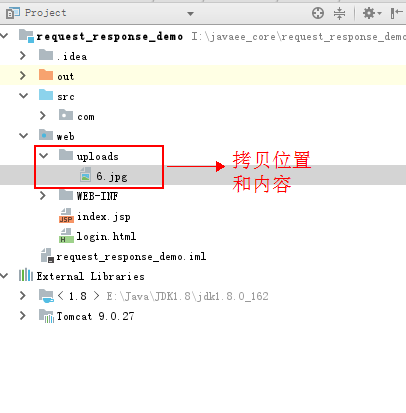
文件下载的Servlet代码如下:
/**
* 文件下载
* @author 黑马程序员
* @Company http://www.itheima.com
*
*/
public class ResponseDemo8 extends HttpServlet {
public void doGet(HttpServletRequest request, HttpServletResponse response)
throws ServletException, IOException {
/*
* 文件下载的思路:
* 1.获取文件路径
* 2.把文件读到字节输入流中
* 3.告知浏览器,以下载的方式打开(告知浏览器下载文件的MIME类型)
* 4.使用响应对象的字节输出流输出到浏览器上
*/
//1.获取文件路径(绝对路径)
ServletContext context = this.getServletContext();
String filePath = context.getRealPath("/uploads/6.jpg");//通过文件的虚拟路径,获取文件的绝对路径
//2.通过文件路径构建一个字节输入流
InputStream in = new FileInputStream(filePath);
//3.设置响应消息头
response.setHeader("Content-Type", "application/octet-stream");//注意下载的时候,设置响应正文的MIME类型,用application/octet-stream
response.setHeader("Content-Disposition", "attachment;filename=1.jpg");//告知浏览器以下载的方式打开
//4.使用响应对象的字节输出流输出
OutputStream out = response.getOutputStream();
int len = 0;
byte[] by = new byte[1024];
while((len = in.read(by)) != -1){
out.write(by, 0, len);
}
in.close();
}
public void doPost(HttpServletRequest request, HttpServletResponse response)
throws ServletException, IOException {
doGet(request, response);
}
}
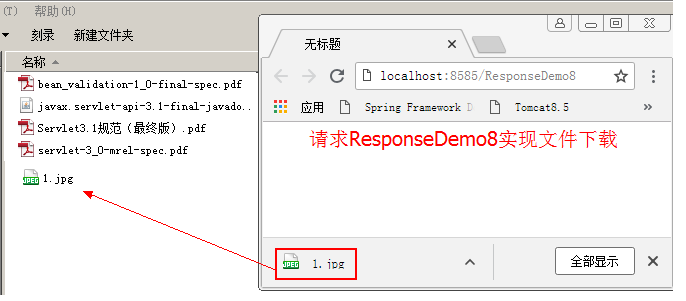
1.3.8 响应对象注意事项
第一: response得到的字符流和字节流互斥,只能选其一
第二:response获取的流不用关闭,由服务器关闭即可
/**
* 使用Response对象获取流时候的注意事项:
* 1.我们使用response获取的流,可以不用关闭。服务器会给我们关闭。
* 2.在response对象中,字节流和字符流互斥,输出的时候,只能选择一个
* @author zhy
*
*/
public class ResponseDemo9 extends HttpServlet {
public void doGet(HttpServletRequest request, HttpServletResponse response)
throws ServletException, IOException {
String str = "test";
response.getOutputStream().write(str.getBytes());
//response.getWriter().write(str);
// response.getOutputStream().write("haha".getBytes());
}
public void doPost(HttpServletRequest request, HttpServletResponse response)
throws ServletException, IOException {
doGet(request, response);
}
}
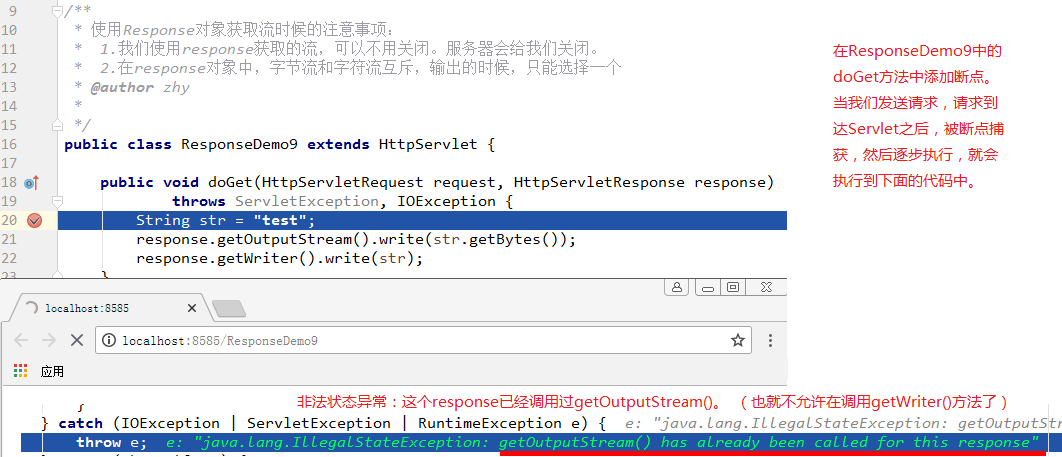
2 请求对象
2.1 请求对象概述
2.1.1 关于请求
请求,顾明思议,就是使用者希望从服务器端索取一些资源,向服务器发出询问。在B/S架构中,就是客户浏览器向服务器发出询问。在我们的JavaEE工程中,客户浏览器发出询问,要遵循HTTP协议所规定的。
请求对象,就是在JavaEE工程中,用于发送请求的对象。我们常用的对象就是ServletRequest和HttpServletRequest,它们的区别就是是否和HTTP协议有关。
2.1.2 常用请求对象
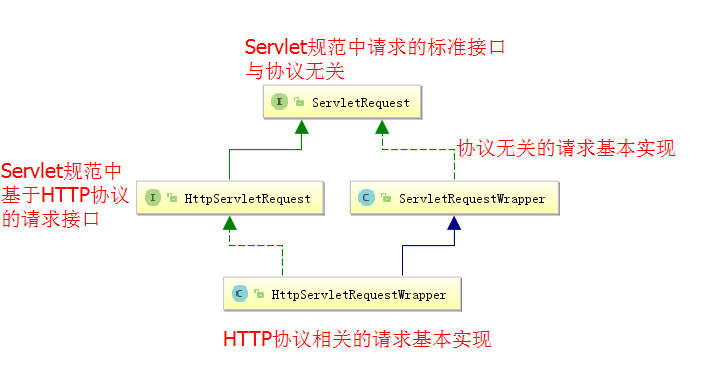
2.2 常用方法介绍
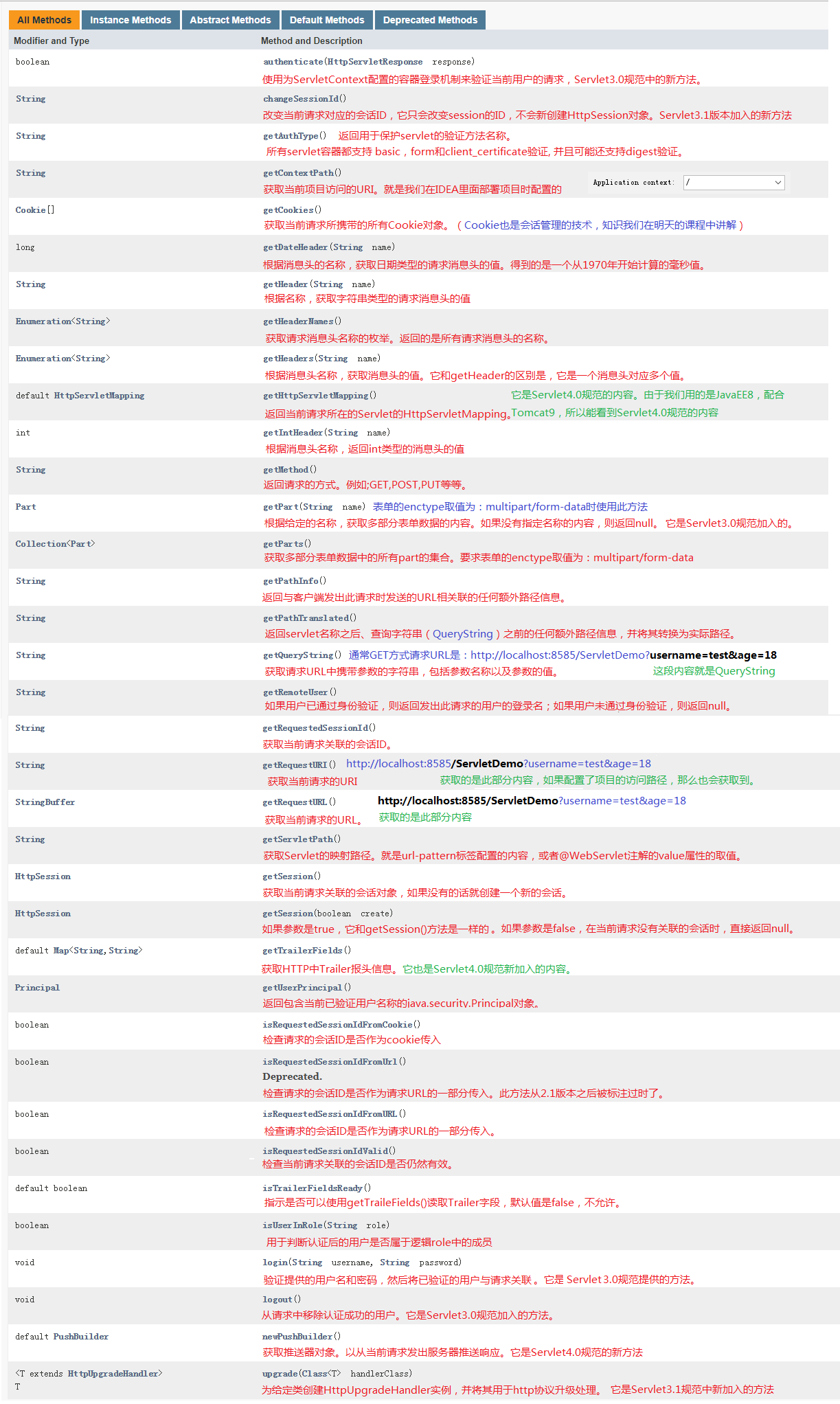
2.3 请求对象的使用示例
2.3.1 请求对象常用方法1-获取各种路径
/**
* 请求对象的各种信息获取
* @author 黑马程序员
* @Company http://www.itheima.com
*/
public class RequestDemo1 extends HttpServlet {
public void doGet(HttpServletRequest request, HttpServletResponse response)
throws ServletException, IOException {
//本机地址:服务器地址
String localAddr = request.getLocalAddr();
//本机名称:服务器名称
String localName = request.getLocalName();
//本机端口:服务器端口
int localPort = request.getLocalPort();
//来访者ip
String remoteAddr = request.getRemoteAddr();
//来访者主机
String remoteHost = request.getRemoteHost();
//来访者端口
int remotePort = request.getRemotePort();
//统一资源标识符
String URI = request.getRequestURI();
//统一资源定位符
String URL = request.getRequestURL().toString();
//获取查询字符串
String queryString = request.getQueryString();
//获取Servlet映射路径
String servletPath = request.getServletPath();
//输出内容
System.out.println("getLocalAddr() is :"+localAddr);
System.out.println("getLocalName() is :"+localName);
System.out.println("getLocalPort() is :"+localPort);
System.out.println("getRemoteAddr() is :"+remoteAddr);
System.out.println("getRemoteHost() is :"+remoteHost);
System.out.println("getRemotePort() is :"+remotePort);
System.out.println("getRequestURI() is :"+URI);
System.out.println("getRequestURL() is :"+URL);
System.out.println("getQueryString() is :"+queryString);
System.out.println("getServletPath() is :"+servletPath);
}
public void doPost(HttpServletRequest request, HttpServletResponse response)
throws ServletException, IOException {
doGet(request, response);
}
}
2.3.2 请求对象常用方法2-获取请求头信息
/**
* 获取请求消息头
* @author 黑马程序员
* @Company http://www.itheima.com
*/
public class RequestDemo2 extends HttpServlet {
public void doGet(HttpServletRequest request, HttpServletResponse response)
throws ServletException, IOException {
//1.根据名称获取头的值 一个消息头一个值
String value = request.getHeader("Accept-Encoding");//////////////////////
System.out.println("getHeader():"+value);
//2.根据名称获取头的值 一个头多个值
Enumeration<String> values = request.getHeaders("Accept");//////////////////////
while(values.hasMoreElements()){
System.out.println("getHeaders():"+values.nextElement());
}
//3.获取请求消息头的名称的枚举
Enumeration<String> names = request.getHeaderNames();/////////////////////
while(names.hasMoreElements()){
String name = names.nextElement();
String value1 = request.getHeader(name);
System.out.println(name+":"+value1);
}
}
public void doPost(HttpServletRequest request, HttpServletResponse response)
throws ServletException, IOException {
doGet(request, response);
}
}
2.3.3 请求对象常用方法3-获取请求参数(非常重要)
在本小节,我们会讲解HttpServletRequest对象获取请求参数的常用方法,以及把获取到的请求参数封装到实体类中的方式。首先,我们先来创建一个Servlet对象
/**
* 封装请求正文到javabean(数据模型)
* @author 黑马程序员
* @Company http://www.itheima.com
*/
public class RequestDemo3 extends HttpServlet {
public void doGet(HttpServletRequest request, HttpServletResponse response)
throws ServletException, IOException {
/*
* 把下面
* 1)获取请求参数
* 2)封装请求参数到实体类中
* 中定义的test1到test8逐个添加到此处来运行即可。
*/
}
public void doPost(HttpServletRequest request, HttpServletResponse response)
throws ServletException, IOException {
doGet(request, response);
}
}
接下来,我们在来准备一个表单页面:
<html>
<head>
<title>login to request demo 3</title>
</head>
<body>
<form action="/day10_1122_requestresponse/RequestDemo3" method="post">
用户名:<input type="text" name="username" /><br/>
密码:<input type="password" name="password" /><br/>
性别:<input type="radio" name="gender" value="1" checked>男
<input type="radio" name="gender" value="0">女
<br/>
<input type="submit" value="注册" />
</form>
</body>
</html>
现在,我们开始分析HttpServletRequest对象用于获取请求参数的方法:
1)获取请求参数
<html>
<head>
<title>login to request demo 4</title>
</head>
<body>
<form action="/day10_1122_requestresponse/RequestDemo4" method="post" enctype="multipart/form-data">
用户名:<input type="text" name="username" /><br/>
密码:<input type="password" name="password" /><br/>
确认密码:<input type="password" name="password" /><br/>
性别:<input type="radio" name="gender" value="1" checked>男
<input type="radio" name="gender" value="0">女
<br/>
<input type="submit" value="注册" />
</form>
</body>
</html>
getParameter()方法的示例代码
getParameterValues()方法的示例代码
getParameterNames()方法的示例代码
getParameter()方法的示例代码
public class ServletDemo03 extends HttpServlet {
@Override
protected void doGet(HttpServletRequest req, HttpServletResponse resp) throws ServletException, IOException {
//1.根据名称获取数据 getParameter()
String username = req.getParameter("username");
System.out.println(username);
String password = req.getParameter("password");
System.out.println(password);
System.out.println("--------------------");
//2.根据名称获取所有数据 getParameterValues()
String[] hobbies = req.getParameterValues("hobby");
for(String hobby : hobbies) {
System.out.println(hobby);
}
System.out.println("--------------------");
//3.获取所有名称 getParameterNames()
Enumeration<String> names = req.getParameterNames();
while(names.hasMoreElements()) {
String name = names.nextElement();
System.out.println(name);
}
System.out.println("--------------------");
//4.获取所有参数的键值对 getParameterMap()//////////////////
Map<String, String[]> map = req.getParameterMap();
for(String key : map.keySet()) {
String[] values = map.get(key);
System.out.print(key + ":");
for(String value : values) {
System.out.print(value + " ");
}
System.out.println();
}
}
总结:
以上四个方法可以获取表单提交过来的请求参数。
参数的名称是一个字符串,参数的值可能是一个字符串,也可能是一个字符串数组。
2)封装请求参数到实体类中
我们通过上面的方法可以获取到请求参数,但是如果参数过多,在进行传递时,方法的形参定义将会变得非常难看。此时我们应该用一个对象来描述这些参数,它就是实体类。这种类的定义,从基础阶段我们就开始使用了。在基础阶段,我们做过一个学生管理系统,用到了一个Student的类,它就是用于描述一个学生的实体类。
我们现在要做的就是把表单中提交过来的数据填充到实体类中。
第一种:最简单直接的封装方式
/**
* 封装请求正文到User对象中 没有使用确认密码
* @param request
* @param response
* @throws ServletException
* @throws IOException
*/
private void test4(HttpServletRequest request, HttpServletResponse response)
throws ServletException, IOException {
//1.获取请求正文
String username = request.getParameter("username");
String password = request.getParameter("password");
String gender = request.getParameter("gender");
//2.创建一个User对象
User user = new User();
System.out.println("封装前:"+user.toString());
//3.把请求正文封装到user对象中
user.setUsername(username);
user.setPassword(password);
user.setGender(gender);
System.out.println("封装后:"+user.toString());
}
第二种:使用反射方式封装
此种封装的使用要求是,表单<input>标签的name属性取值,必须和实体类中定义的属性名称一致。
/**
* 封装请求正文到javabean中 没有使用确认密码
* 使用反射+内省实现数据模型的封装
* 内省:是sun公司推出的一套简化反射操作的规范。把javabean中的元素都封装成一个属性描述器。
* 属性描述器中会有字段信息,get和set方法(取值或存值)
* @param request
* @param response
* @throws ServletException
* @throws IOException
*/
private void test5(HttpServletRequest request, HttpServletResponse response)
throws ServletException, IOException {
//1.获取请求正文名称的枚举
Enumeration<String> names = request.getParameterNames();
User user = new User();
System.out.println("封装前:"+user.toString());
//2.遍历正文名称的枚举
while(names.hasMoreElements()){
String name = names.nextElement();
String value = request.getParameter(name);
try{
//1.拿到User对象中的属性描述器。是谁的属性描述器:是由构造函数的第一个参数决定的。第二个参数是指定javabean的字节码
PropertyDescriptor pd = new PropertyDescriptor(name, User.class);//参数指的就是拿哪个类的哪个属性的描述器
//2.设置javabean属性的值
Method method = pd.getWriteMethod();
//3.执行方法
method.invoke(user, value);//第一个参数是指的给哪个对象,第二个参数指的是赋什么值
}catch(Exception e){
e.printStackTrace();
}
}
System.out.println("封装后:"+user.toString());
}
第三种:使用反射封装,同时请求参数的值是一个数组
此种方式其实就是针对请求参数中包含name属性相同的参数,例如:密码和确认密码,还有爱好。
/**
* 获取请求正文的关系映射Map<String,String[]> 使用确认密码
* @param request
* @param response
* @throws ServletException
* @throws IOException
*/
private void test6(HttpServletRequest request, HttpServletResponse response)
throws ServletException, IOException {
//1.获取请求正文的映射关系
Map<String,String[]> map = request.getParameterMap();
//2.遍历集合
for(Map.Entry<String,String[]> me : map.entrySet()){
String name = me.getKey();
String[] value = me.getValue();
System.out.println(name+":"+Arrays.toString(value));
}
}
当我们把请求参数获取出来之后,就要考虑如何针对数组的反射了,具体代码如下:
/**
* 封装请求正文到javabean。使用的是反射+内省 使用了确认密码
* @param request
* @param response
* @throws ServletException
* @throws IOException
*/
private void test7(HttpServletRequest request, HttpServletResponse response)
throws ServletException, IOException {
//1.获取请求正文的映射关系
Map<String,String[]> map = request.getParameterMap();
Users user = new Users();
System.out.println("封装前:"+user.toString());
//2.遍历集合
for(Map.Entry<String,String[]> me : map.entrySet()){
String name = me.getKey();
String[] value = me.getValue();
try{
//1.拿到User对象中的属性描述器。是谁的属性描述器:是由构造函数的第一个参数决定的。第二个参数是指定javabean的字节码
PropertyDescriptor pd = new PropertyDescriptor(name, Users.class);//参数指的就是拿哪个类的哪个属性的描述器
//2.设置javabean属性的值
Method method = pd.getWriteMethod();
//3.执行方法
//判断参数到底是几个值
if(value.length > 1){//最少有2个元素
method.invoke(user, (Object)value);//第一个参数是指的给哪个对象,第二个参数指的是赋什么值
}else{
method.invoke(user, value);//第一个参数是指的给哪个对象,第二个参数指的是赋什么值
}
}catch(Exception e){
e.printStackTrace();
}
}
System.out.println("封装后:"+user.toString());
}
当我们写完此种封装方式之后,同学们可以发现,我们绝大多数封装都可以使用这段代码来实现。并且,无论是谁来写这段通用的封装代码,其代码内容都是大同小异的。那么,我们就可以得出一个很有趣的结论:一般遇到这种情况时,肯定有人帮我们写好了,我们只需要用就行了。我们后面还会遇到类似这样的情况。
此时,帮我们写好这段封装代码的是apache软件基金会,我们前面学习的tomcat也是它提供的。它里面有一个开源工具包集合commons,里面有很多开源工具类,今天我们就来讲解第一个:commons-beanutils。
第四种:使用apache的commons-beanutils实现封装
实现代码:
/**
* 终极方法:使用beanutils实现请求正文封装到javabean中 使用了确认密码
* 要想使用beanutils,需要先导包
* @param request
* @param response
* @throws ServletException
* @throws IOException
*/
private void test8(HttpServletRequest request, HttpServletResponse response)
throws ServletException, IOException {
Users user = new Users();
System.out.println("封装前:"+user.toString());
try{
BeanUtils.populate(user, request.getParameterMap());//就这一句话
}catch(Exception e){
e.printStackTrace();
}
System.out.println("封装后:"+user.toString());
}
2.3.4 用流的形式读取请求信息
我们除了使用2.3.3小节中获取请求参数之外,还可以使用下面代码中的 方式来获取:
/**
* 使用流的方式读取请求正文
* @author 黑马程序员
* @Company http://www.itheima.com
*/
public class RequestDemo4 extends HttpServlet {
public void doGet(HttpServletRequest request, HttpServletResponse response)
throws ServletException, IOException {
//1.获取请求正文的字节输入流
ServletInputStream sis = request.getInputStream();
//2.读取流中的数据
int len = 0;
byte[] by = new byte[1024];
while((len = sis.read(by)) != -1){
System.out.println(new String(by,0,len));
}
}
public void doPost(HttpServletRequest request, HttpServletResponse response)
throws ServletException, IOException {
doGet(request, response);
}
}
2.3.5请求正文中中文编码问题
关于请求中文乱码问题,我们需要分开讨论,第一是POST请求方式,第二是GET方式。
1)POST方式请求
在POST方式请求中,我们的乱码问题可以用如下代码解决:
/**
* 请求正文的中文乱码问题
* @author 黑马程序员
* @Company http://www.itheima.com
*/
public class RequestDemo5 extends HttpServlet {
public void doGet(HttpServletRequest request, HttpServletResponse response)
throws ServletException, IOException {
//1.获取请求正文
/*POST方式:
* 问题:
* 取的时候会不会有乱码
* 答案:
* 获取请求正文,会有乱码问题。
* 是在获取的时候就已经乱码了。
* 解决办法:
* 是request对象的编码出问题了
* 设置request对象的字符集
* request.setCharacterEncoding("GBK");它只能解决POST的请求方式,GET方式解决不了
* 结论:
* 请求正文的字符集和响应正文的字符集没有关系。各是各的
*/
request.setCharacterEncoding("UTF-8");/////////////////////////////////
String username = request.getParameter("username");
//输出到控制台
System.out.println(username);
//输出到浏览器:注意响应的乱码问题已经解决了
response.setContentType("text/html;charset=UTF-8");
PrintWriter out = response.getWriter();
out.write(username);
}
public void doPost(HttpServletRequest request, HttpServletResponse response)
throws ServletException, IOException {
doGet(request, response);
}
}
2)GET方式请求
GET方式请求的正文是在地址栏中,在Tomcat8.5版本及以后,Tomcat服务器已经帮我们解决了,所以不会有乱码问题了。
而如果我们使用的不是Tomcat服务器,或者Tomcat的版本是8.5以前,那么GET方式仍然会有乱码问题,解决方式如下:(以下代码了解即可,因为我们现在使用的是Tomcat9.0.27版本)
/**
* 在Servlet的doGet方法中添加如下代码
*/
public void doGet(HttpServletRequest request, HttpServletResponse response)
throws ServletException, IOException {
/*
* GET方式:正文在地址栏
* username=%D5%C5%C8%FD
* %D5%C5%C8%FD是已经被编过一次码了
*
* 解决办法:
* 使用正确的码表对已经编过码的数据进行解码。
* 就是把取出的内容转成一个字节数组,但是要使用正确的码表。(ISO-8859-1)
* 再使用正确的码表进行编码
* 把字节数组再转成一个字符串,需要使用正确的码表,是看浏览器当时用的是什么码表
*/
String username = request.getParameter("username");
byte[] by = username.getBytes("ISO-8859-1");
username = new String(by,"GBK");
//输出到浏览器:注意响应的乱码问题已经解决了
response.setContentType("text/html;charset=UTF-8");
PrintWriter out = response.getWriter();
out.write(username);
}
public void doPost(HttpServletRequest request, HttpServletResponse response)
throws ServletException, IOException {
doGet(request, response);
}
2.3.6 请求转发(与重定向的区别)
在实际开发中,重定向和请求转发都是我们要用到的响应方式,那么他们有什么区别呢?我们通过下面的示例来看一下:
/**
* 重定向特点:
* 两次请求,浏览器行为,地址栏改变,请求域中的数据会丢失
* 请求转发:
* 一次请求,服务器行为,地址栏不变,请求域中的数据不丢失
*
* 请求域的作用范围:
* 当前请求(一次请求),和当前请求的转发之中
* @author 黑马程序员
* @Company http://www.itheima.com
*/
public class RequestDemo6 extends HttpServlet {
public void doGet(HttpServletRequest request, HttpServletResponse response)
throws ServletException, IOException {
//1.拿到请求调度对象
RequestDispatcher rd = request.getRequestDispatcher("/RequestDemo7");//如果是给浏览器看的,/可写可不写。如果是给服务器看的,一般情况下,/都是必须的。
//放入数据到请求域中
request.setAttribute("CityCode", "bj-010");///////////////
//2.实现真正的转发操作
rd.forward(request, response);//实现真正的转发操作//////////////////
}
public void doPost(HttpServletRequest request, HttpServletResponse response)
throws ServletException, IOException {
doGet(request, response);
}
}
/**
* 转发的目的地
* @author 黑马程序员
* @Company http://www.itheima.com
*/
public class RequestDemo7 extends HttpServlet {
public void doGet(HttpServletRequest request, HttpServletResponse response)
throws ServletException, IOException {
//获取请求域中的数据
String value = (String)request.getAttribute("CityCode");/
response.getWriter().write("welcome to request demo 7 "+value);
}
public void doPost(HttpServletRequest request, HttpServletResponse response)
throws ServletException, IOException {
doGet(request, response);
}
}
2.3.7 请求包含
在实际开发中,我们可能需要把两个Servlet的内容合并到一起来响应浏览器,而同学们都知道HTTP协议的特点是一请求,一响应的方式。所以绝对不可能出现有两个Servlet同时响应方式。那么我们就需要用到请求包含,把两个Servlet的响应内容合并输出。我们看具体使用示例:
/**
* 请求包含
*
* 它是把两个Servlet的响应内容合并输出。
* 注意:
* 这种包含是动态包含。
*
* 动态包含的特点:
* 各编译各的,只是最后合并输出。
* @author 黑马程序员
* @Company http://www.itheima.com
*/
public class RequestDemo8 extends HttpServlet {
public void doGet(HttpServletRequest request, HttpServletResponse response)
throws ServletException, IOException {
response.getWriter().write("I am request demo8 ");
//1.拿到请求调度对象
RequestDispatcher rd = request.getRequestDispatcher("/RequestDemo9");
//2.实现包含的操作
rd.include(request, response);
}
public void doPost(HttpServletRequest request, HttpServletResponse response)
throws ServletException, IOException {
doGet(request, response);
}
}
/**
* 被包含者
* @author 黑马程序员
* @Company http://www.itheima.com
*/
public class RequestDemo9 extends HttpServlet {
public void doGet(HttpServletRequest request, HttpServletResponse response)
throws ServletException, IOException {
response.getWriter().write("include request demo 9 ");
}
public void doPost(HttpServletRequest request, HttpServletResponse response)
throws ServletException, IOException {
doGet(request, response);
}
}
2.3.8 细节问题
请求转发的注意事项:负责转发的Servlet,转发前后的响应正文丢失,由转发目的地来响应浏览器。
请求包含的注意事项:被包含者的响应消息头丢失。因为它被包含起来了。
3 案例中的使用
3.1 案例的需求及环境
3.1.1 案例需求介绍
在昨天的课程中,我们实现了浏览器发送请求,由Servlet来接收。今天,我们继续对学生管理系统进行升级,通过Servlet来实现学生的新增,删除,修改,查询操作。
新增:Create
查询:Read
修改:Update
删除:Delete
每个单词取第一个字母,组成了CRUD。所以,同学们今后看到CRUD操作,指的就是增删改查。
今天案例的CRUD,我们只关注Servlet接收请求和处理响应,不用过多的去关注真正增删改查操作(因为,我们目前还是把学生信息写到文件中,等web5天课程结束,我们会讲解数据库,它是我们保存数据这类问题的终极解决方案,而保存文件只是个替代品,我们没必要在替代品处消耗太多精力)。



